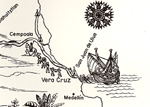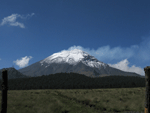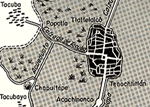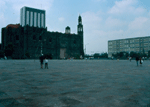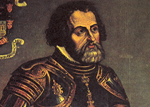Cortés
(Hernán Cortés, 1485 - 1547)

1485 Born in Medellín (
1504 Cortés went to
1511 He accompanied governor Diego Velázquez to
1518-1519 Cortés recruited men from various places in Cuba, but most
notably, he stopped in the old Cuban port of Casilda, near Trinidad and Playa
Ancón. For a view of a place close to this Cuban site, see: => Ancón #2.
1518 November 18: Without permission from governor
Velázquez, Cortés began his trip to México with 11 ships, 508 soldiers, 100
seamen, 16 horses, 10 cannons, and 13 shotguns (arcabuces).
1519 March 12: He arrived at
He
founded the city of
To
follow Cortés' cohort from
Cortés
ordered his ten ships dismantled and run aground. (That he had the ships burned
is a fun legend, but it’s not true.) The purpose of destroying his ships, which
he had done gradually and surreptitiously, was to cut off all means of retreat
for some of his disgruntled men, thus signaling his intention to push forward
into the Mexican interior and to find the “great city of Tenochtitlán,” about
which the coastal inhabitants had told stories of fabulous riches and a
magnificent emperor (tlatoani).
Marching
into the interior, Cortés' forces encounter the Tlaxcalans, whose territory on
the NE edge of Lake Texcoco was independent from direct Aztec control. The
Tlaxcalans were enemies of the Aztecs. At first they fought against the
Spaniards, but, after being defeated, they later allied permanently with
Cortés' forces.
From
Tlaxcala Cortés decided not to take a route to meet Moctezuma in Tenochtitlán
as recommended by messengers from the Mexica tlatoani, but rather he led his combined Spanish and indigenous
forces south along the east side of the great Trans-Mexican Volcanic Belt (Eje
Volcánico Transversal), which is also known as the Sierra Nevada. There he encountered the great city of
Cholula, whose people both were allied with the Aztecs and were fearful of
them. This is where Cortés carried out a demonstration massacre, the result of
which was to cause a number of other nearly tribes to join forces against the
Aztecs.
From
Cholula, Cortés marched his forces up over the Sierra Nevada between the
legendary twin volcanic peaks of Iztaccíhuatl and Popocatépetl.
Cortés
crossed the lake and entered Tenochtitlán with his Spanish forces and with
1,000 Tlaxcaltecas.
Cortés
was greeted peacefully by Moctezuma, emperor of the Aztecs (tlatoani), who early on had thought that
Cortés was Quetzalcóatl returning as this demigod had supposedly promised five
hundred years earlier, first at Tula, and later on the coast of Yucatán.
November
8, 1519, Moctezuma made a grand procession from his palace in Tenochtitlán to
greet Cortés and his men on the south side of the lake. For an anonymous document
in which a Náhuatl-speaking Aztec records the Mexican perspective on this
monumental and peaceful first encounter, click on the Document button below.
When
Cortés heard that some Mexican (i.e., Aztecs) had attacked the Spanish
rearguard at
For
a simple map of the area around Tenochtitlán, click on the following image:
1520 Meanwhile, Velázquez sent Pánfilo de Narváez (of
failed
A
battle took place on May 24th between Narváez's forces and Cortés's.
The latter won, wounding Narváez in the process (he lost his eye; in
On
the return march back up to the Tenochtitlán, the Aztecs fought against
Cortés's large force of Spaniards because, when Cortés was absent from the
capital, Alvarado, fearing a nighttime attack by Aztec warriors who were
dancing in a (wild: Spanish view) ritual ceremony at the Great Temple of
Tenochtitlán, did a preemptive strike against the Mexicans. War then broke out
in Tenochtitlán. When Cortés returned with his new large force he had to fight
his way into the center of the city. The fighting was so fierce, and the
Spaniards were so outnumbered, that Cortés ordered a full retreat from the city.
They had to fight their way out of the city. This retreat, which was a
disaster, but not a total defeat, for the Spaniards, is known as la Noche Triste (the sad night). During
the fighting Moctezuma was killed (either by Aztecs themselves or by the Spaniards:
versions vary).
Cortés's
troops were well received in Tlaxcala; he regrouped his forces there; increased
the size of his mixed army; and planned his counterattack.
1521 In order to reconquer Tenochtitlán, Cortés
established his battle headquarters in Coyoacán, at the time a small Aztec on
the south side of lake Texcoco. Nowadays Coyoacán (Aztec => “place of
coyotes”), one of the sixteen boroughs (Spanish => (delegaciones) of Mexico City. It is located about seven miles south
of Mexico City’s central plaza, known as the zócalo, where one finds the ruins of the Aztec’s Great Temple and
the Metropolitan Cathedral. In itself, Coyoacán is a lovely middle class town
with a population of about 700,000 people. Now it is famous for the homes of
Diego Rivera, Frida Kahla, and Leon Trotsky. In 1521 the town’s Tepanec people
welcomed Cortés in order to overthrow Moctezuma’s oppressive control over them.
Cortés made Coyoacán New Spain’s first capital, and, in 1521-1522, he lived in
the residence of the town Tepanec leader, Juan de Guzmán Iztolinque (his name
upon conversion). Furthermore, he constructed various Spanish colonial
government buildings here. The Municipal House, known as the Casa de Cortés,
was built on this site in the 18th century. Shortly, thereafter,
when he was named Marqués de Valle de Oaxaca, he built the administrative
center for his vast land holdings, part of which was the Tepanec area of
Coyoacán. A popular belief is that Cuauhtémoc, the Aztec’s last (and most
heroic) emperor, was tortured here, although it is more likely that he was
tortured in Guatemala. For a photo tour of Coyoacán’s central square (Plaza
Hidalgo), with, typical of Spanish municipal urban planning, the Casa Municipal
on one side and the cathedral on the other, see: =>
August
13: After bitter fighting bridge by bridge, street by street, and house by
house in Tlatelolco much of which was demolished as they marched forward—the
Spaniards succeeded in recapturing Tenochtitlán and Tlatelolco. The new Aztec
emperor (a national hero in
For
a brief photographic tour of the Plaza de Tlatelolco and references to events
there of both 1521 and 1968, click on the following image:
1521-1524 Cortés ruled Tenochtitlán while expanding Spanish control over
all former Aztec territory. He lived like a prince and statesman; he organized
the government; he reorganized the lands he controlled with the encomienda system; he studied all its
resources; he exploited its mines; he became fabulously rich.
1524-1526 Cortés led an expedition of discovery and conquest to
1528 Because king Carlos I (V) of
1529 The king partially rewarded Cortés by naming
him Marqués del Valle de
1535-1550 Antonio de Mendoza (1495-1552) became the
first viceroy of Nueva España (
1535 Cortés led a new exploration
toward the west of
1535-1541 Cortés remained in México. When he was
not out on an expedition he lived retired on his estate in Cuernavaca
(called the Hacienda de Cortés,
which nowadays is the site of a fine restaurant). The thick-walled, fortified
palace was built in 1526 for him and his second wife, Juana Zúñiga. The site
had been a Tlahuica-Aztec building used for collection of tribute to the Mexica
rulers, but Cortés had it razed to build his residence, from which he imposed
his authority and power over the conquered people. From here and his two other
residences he threw himself into various enterprises: silver mines, cattle and
hog ranches, gold exploration, ship building on Mexico’s Pacific coast, farms
of maize, beans, and wheat; buying and selling slaves, silkworm production from
his importation of mulberry trees, sugarcane, and monuments to himself; he even
designed and had constructed what at the time was a kind of shopping mall in
the center of Mexico City.
1541 He returned to
1547 He died in a town near Sevilla
in southern Spain wealthy but un-honored by the Spanish royal court.
Cortés in
Latin American humanities: He was a learned man who embodied many of the
dynamic aspects of the early Renaissance in
For an enlargement of a portrait of Cortés and for a
brief photographic tour of
